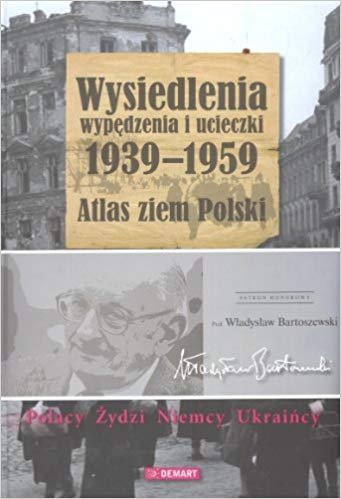Polokaust Population Transfers Hryciuk

Wysiedlenia, Wypedzenia, i Ucieczki, 1939-1959 by Grzegorz Hryciuk et al. (eds.) 2008
Not Only Jews Lost Property. Millions of Poles Were Translocated During and After World War II
POPULATION TRANSFERS, EXPULSIONS, AND ESCAPES, 1939-1959 is the title of this Polish-language annotated encyclopedic atlas. Every imaginable form of population relocation that took place during the relevant period is covered, and described with statistics and maps. Poles, Germans, Jews, Ukrainians, and other groups are considered. In my review, I emphasize the Poles.
The average reader is accustomed to the one-sided likes of Jan T. Gross (on Polish acquisitions of post-Jewish properties) and Ericka Steinbach (on German expellees: the vertriebene). Such a reader may well be shocked at the extent of population relocations of Poles, often with permanent loss of property. Of course, this doesn’t include wartime losses of life and destruction of property.
POLAND UNDER GERMAN OCCUPATION
Soon after the German-Soviet conquest of Poland in 1939, the western and northern parts of German-occupied Poland were incorporated directly into the Reich. A total of 414,000 Poles were expelled and moved to the GG (General Government). (p. 63). To replace them, 720,000 Germans were relocated from the German-controlled parts of the USSR to Wartheland. (pp. 160-161).
Throughout German-occupied Poland, 600,000–800,000 Poles were sent to concentration camps. (p. 62). About 1.9 million Poles were deported to the Reich for forced labor. (pp. 85-87). In order to provide housing for the German occupation forces and administration, some 171,000 Poles were expelled from their domiciles. (p. 65). In addition, during “Operation Zamosc”, some 116,000 Poles were deported in order to be replaced with German colonists. A detailed map (pp. 66-67) shows the depopulated villages and the sites of Polish guerrilla warfare (mostly the BCh) that eventually thwarted this German operation. Another 500,000 Poles were expelled from Warsaw after the fall of the Soviet-betrayed Warsaw Uprising, and Warsaw was systematically almost completely destroyed. (p. 65).
THE POLES DEPORTED INTO THE INTERIOR OF THE SOVIET UNION
Some of the maps in this atlas alone make it worth having. For instance, there is a detailed map of the location of Polish deportees throughout the USSR. (p. 55). Unfortunately, the authors use unreliable Soviet sources that greatly underestimate the number of Poles (about 1.2 million) deported from the Kresy to the interior of the USSR (1939-1941).
AFTER WORLD WAR II
The end of WWII was not the end, but the beginning, of population dislocations throughout Poland. The much-discussed expulsion of Germans from Poland was only half the story. The Kresy (Poland’s eastern half) Poles–those who had survived the earlier Soviet and German deportations, Ukrainian fascist-separatist (OUN-UPA, or UIA) genocide, etc.–were now expelled by the Soviets as part of their annexation process–the fruits of Teheran (1943). In 1944-1946, 618,200 Poles were forced to leave Eastern Galicia (269,500 from eastern Lwow Voivodship, 97,300 from Stanislawow Voivodship, and 251,500 from Tarnopol Voivodship). In addition, 133,900 Poles were expelled from Wolyn (Volhynia) Voivodship. The corresponding numbers of Poles expelled from the Byelorussian and Lithuanian parts of the Soviet-annexed Kresy amounted to 226,315 and 375,600, respectively. (p. 85).
A few thousand “Andersites” (supporters of a free and democratic Poland) who remained in the Kresy were deported into the interior of the USSR in 1951. (pp. 96-97). Also, during 1944-1952, about 200,000 Kresy Ukrainians were deported into the interior of the USSR as part of the Soviet crackdown on the OUN-UPA. (p. 211). Interestingly, the AK (A. K., Armia Krajowa) continued fighting in the Byelorussian parts of the erstwhile Kresy until 1952. (p. 82).
According to the 1959 Soviet census, 2 million fewer people lived in the Kresy in 1959 than had in 1939 when it was part of Poland. The percentages (numbers) of remaining 1959 Kresy Poles are listed as follows by sub-region: Western Ukraine–1.7% (104,000), Western Byelorussian–16.1% (483,000), and Lithuanian–40.1% (185,000). (p. 20).
To see a series of truncated reviews in a Category click on that Category:
- All reviews
- Anti-Christian Tendencies
- Anti-Polish Trends
- Censorship on Poles and Jews
- Communization of Poland
- Cultural Marxism
- German Guilt Dilution
- Holocaust Industry
- Interwar Polish-Jewish Relations
- Jewish Collaboration
- Jewish Economic Dominance
- Jews Antagonize Poland
- Jews Not Faultless
- Jews' Holocaust Dominates
- Jews' Holocaust Non-Special
- Nazi Crimes and Communist Crimes Were Equal
- Opinion-Forming Anti-Polonism
- Pogrom Mongering
- Poland in World War II
- Polish Jew-Rescue Ingratitude
- Polish Nationalism
- Polish Non-Complicity
- Polish-Ukrainian Relations
- Polokaust
- Premodern Poland
- Recent Polish-Jewish Relations
- The Decadent West
- The Jew as Other
- Understanding Nazi Germany
- Why Jews a "Problem"
- Zydokomuna